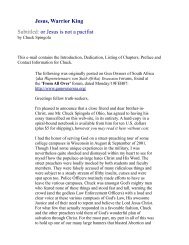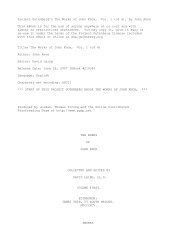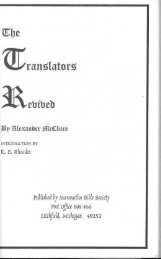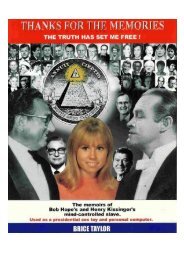THE PINK SWASTIKA - Shattering Denial
THE PINK SWASTIKA - Shattering Denial
THE PINK SWASTIKA - Shattering Denial
Create successful ePaper yourself
Turn your PDF publications into a flip-book with our unique Google optimized e-Paper software.
Jorg Lanz von Liebenfels and Ariosophy<br />
If any occultist can be said to have had more influence on Hitler and the Nazis than List it would be<br />
Jorg Lanz von Liebenfels (1874-1954). Lanz was a former Cistercian Monk who had been thrown out<br />
of the order “for carnal and worldly desires” (Sklar:19). Since the Cistercian Order was a closed, allmale<br />
monastery, it is assumed that Lanz's indiscretions were of a homosexual nature. German writer<br />
Friedrich Buchmayr noted the following about Lanz<br />
[F]ollowing his ordination in 1898, as a priest, Lanz was put to use as a teacher of choir boys. In April<br />
of 1899, the 24-year-old left the order, stating his reason for this step as “increasing nervousness” and<br />
“irritation.” In the Chapter Book his departure was accounted to “carnal loves.” His later radical hatred<br />
of women suggests a failed relationship with women (Buchmayr, Biographisch- Bibliographisches<br />
Kirchenlexikon, Vol. XVI, 1999)<br />
It was through Lanz that Hitler would learn that many of his heroes of history were also “practicing<br />
homosexuals” (Waite, 1977:94f). After being expelled from the monastery, Lanz formed his own<br />
occultic order called the Ordo Novi Templi or the Order of the New Temple (ONT). The ONT was<br />
related to the Ordo Templi Orientis or Order of the Temple of the East, which, like List’s organization,<br />
practiced tantric sexual rituals (Howard:91).<br />
Hitler was aware that Lanz was a homosexual, according to Frau Elsa Schmidt-Falk of the Nazi<br />
Genealogy Office of Munich, as reported by Daim. Schmidt-Falk frequently spoke with Hitler<br />
personally in her role as a genealogical researcher whose task was to verify the racial purity of highlyplaced<br />
Nazis. She did not conclude from her discussions that Hitler was personally associated with<br />
Lanz (although he may have been) but she reported that<br />
Lanz was also mentioned once in the following connection: a convicted homosexual had addressed a<br />
plea for clemency to Hitler, in which he designated [Lanz] as a homosexual. Hitler allowed this man to<br />
disappear...immediately....[At another time] Hitler mentioned Roehm, Heines, etc. and also Lanz von<br />
Liebenfels and his group, about which (group) he (Hitler) at least accepted that it was actively<br />
homosexual (Daim:41).<br />
Both List’s and Lanz’ organizations were modeled on the Teutonic Knights and the Knights<br />
Templars, militaristic monastic orders founded in 1118 A.D. to fight in the Crusades (Goodrick-Clarke:<br />
60). Following the crusades, the Templars returned to Europe, but did not demobilize. Instead the<br />
members established monasteries which became centers of trade and influence. In the early 1300s the<br />
Knights Templars were condemned by Pope Innocent III for homosexual perversion and occultic<br />
practices. They were brought to trial and disbanded by King Philip the Fair of France. Igra writes,<br />
[Homosexuality’s] morbid history in the German blood dates from the time of the Teutonic<br />
Knights...Their personal lives were as infamous as the more widely publicized infamies of their brother<br />
Knights, the Templars. These latter became so corrupt that they raised the practice of their cardinal<br />
vice [homosexuality] into a religious cult...There were innumerable public trials where the most<br />
revolting details were brought to light (Igra:18).<br />
Others have confirmed the prevalence of homosexuality among the Teutonic Knights. Adolf Brand,<br />
writing in Der Eigene, said of the Teutons (from whom the Teutonic Knights take their name), that “the<br />
Edda [Norse mythology] extols it [homosexuality] as the highest virtue of the Teutons (Brand in<br />
Oosterhuis and Kennedy:236f). Nazi leaders, especially Himmler, were infatuated with the Teutons.<br />
Sklar writes that “Like List and Lanz, Himmler was obsessed with...the Order of the Teutonic Knights”<br />
and that he “saw his Black Guards [the S.S.] as an elite cadre of Teutonic warriors” (Sklar:14ff).<br />
Likewise, Frederick the Great, Hitler’s personal hero, “revived the vices of the Teutonic Knights” in









